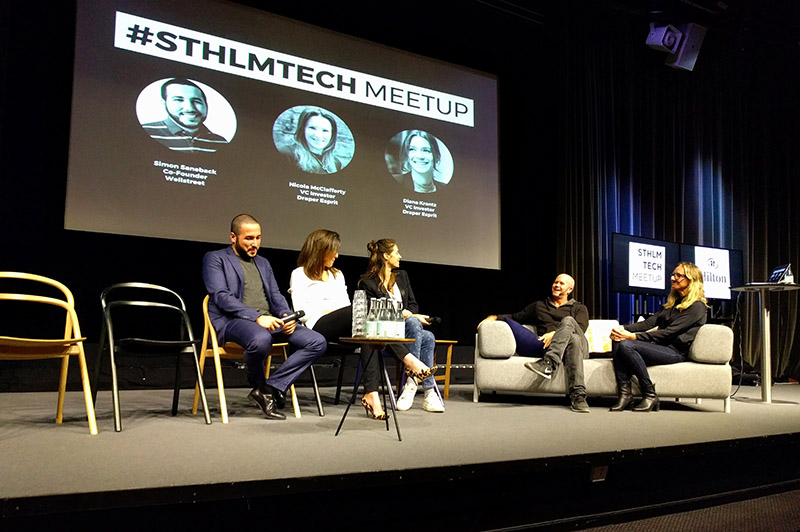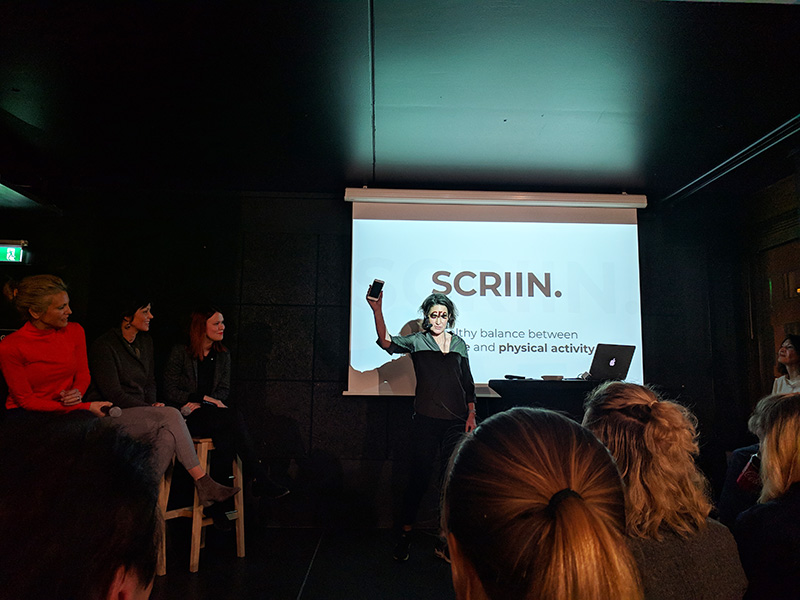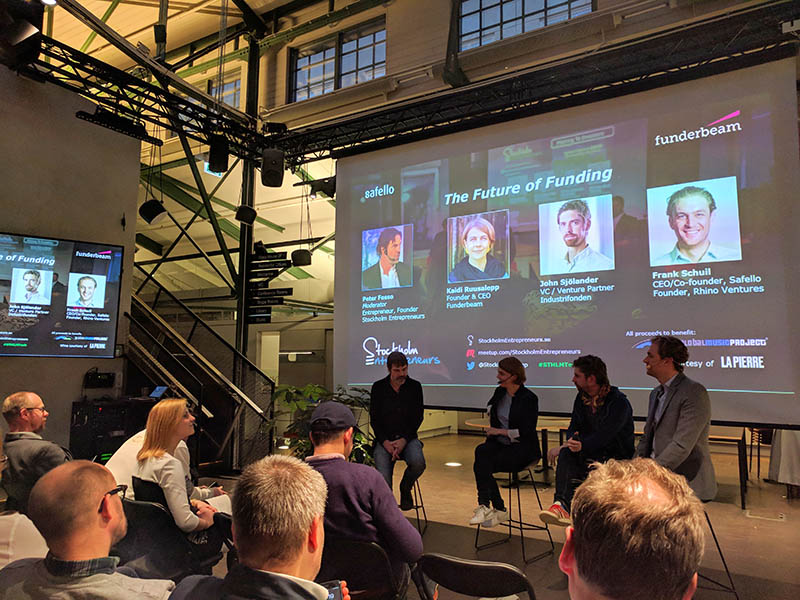The Pitch
At a Stockholm-based entrepreneur meetup, two entrepreneurs stood on stage ready to pitch their startup to a panel of venture capital investors (VCs).[1] The man clicked the laptop button to display their first slide—a large image of their logo. “Hello! I am Per and this is Jonna and this is our startup, Forests! We are on a mission to understand the world’s forests and their inhabitants.” Jonna moved to the second slide and told the story of an endangered forest-dwelling animal. On the next slide, Per talked more specifically about the importance of the world’s forests to global climate change. On the fourth slide, the endangered animal appeared again. “Oh, this guy again!” the event’s moderator interrupted with an exaggerated tone of exhaustion. The entrepreneurs laughed nervously and continued to talk about the grand mission of their company to support climate research with crowdsourced data from birders, amateur naturalists, and other forest enthusiasts. The moderator interrupted again: “Let’s pause there because I think we are about to get to the good stuff. But, that was a very lengthy Swedish introduction!”
Throughout my year conducting field research in SthlmTech, Stockholm’s entrepreneurial ecosystem, I learned how to “properly” hype a startup alongside Stockholm’s entrepreneurs. From public pitches to educational programming at universities, incubators, and accelerators to informal mentorship and casual advice, hyping is taught as a skill essential to entrepreneurial success. Swedish entrepreneurs were frequently teased or ridiculed for their stereotypical inability or aversion to hype like their American counterparts. Swedish and Scandinavian cultural concepts like jantelagen (the law of jante, social norm of humbleness and rejection of personal aggrandizement) or lagom (not too little, not too much) were used to explain the social norms of humbleness and care for community over individual achievement among Swedes—qualities that were perceived as something that must be overcome to become successful entrepreneurs. The Forests pitch with its focus on impact, community, and care typified what was commonly critiqued as a “Swedish” pitch.

A panel of venture capital investors at STHLM Tech Meetup, one of Stockholm’s meetup events that features public pitching. (Image by Author)
At the end of the pitch, the entrepreneurs displayed a QR code and a short URL for the audience to download the app. At least half of the two hundred or so attendees lifted their phones to capture it. Although they were mostly entrepreneurs and other entrepreneurial stakeholders, they were also predominantly Swedes—people from a country that has been repeatedly ranked as the most sustainable country in the EU and the world, who have the legal right to wander in Sweden’s forests (allemansrätten), and who repeatedly told me “Det finns inget dåligt väder, bara dåliga kläder” (There is no bad weather, only bad clothes) when I protested about winter’s cold or summer’s endless sun. For this audience, Forests’s hype was well matched to their interests and concerns.
The moderator asked the panel of Swedish venture capital investors, “What is going through your mind now? I would guess: how do they make money.” The first investor said, “I still, I just, I don’t know what they do.” The second, with a bit less incredulity, added, “I guess I don’t know what exactly they are collecting, what they are collecting it for, or how they will make money from collecting it.” After a brief pause, the first investor said, “Ok, so this is like social media for hikers. I like that. It seems like a nice app. And, I guess you would be collecting a unique data set that no one else has. And, that gets me excited because as soon as you have unique data you can always use it for something. But then, I guess this is where I struggle. I don’t get why this data is important. I get that this data is important for conservation which I think is great. But, how do you go from having that data to having an impact and making money from it.”
Forests’s co-founders had hyped their app well to the audience. In addition to the many who downloaded the app from their seats, the idea and its necessity in regards to climate change were a popular discussion at the after-event mixer. Yet, the investor panel was unsatisfied. Popular understandings of hype see it as having a “tendency toward excess” that casts it as “a pejorative, a cacophony from which most people want to distance themselves” (Powers 2011, 217). During my fieldwork, discussions about hype with entrepreneurs were often bogged down by conceptions of hype as cynical, false, or deceptive speech or rhetoric. Hype was something that “had to be done” to achieve one’s goals. The term was used almost exclusively to describe the kind of storytelling that was valued by venture capital investors (e.g. promotion of specific technologies, growth potentials, and potentials of achieving the coveted unicorn status) and typified by stereotypes of American, Silicon Valley entrepreneurs. It was almost never used to describe the storytelling that was valued by entrepreneurs as part of expressing their missions, goals, and solutions. Both of these, however, I am categorizing as hype storytelling.
Hype Storytelling
Hype is not simply a cynical form of aggrandizement but also, as Kaushik Sunder Rajan found among biotechnology companies in Silicon Valley, hype is a promissory discourse in a speculative marketplace that calls “the future to account for the present” (Rajan 2006, 116). Setting aside the cynical perspective on hype, he argues that hype is a credible, fabricated truth that entrepreneurs and investors work toward rather than a fabricated lie that is meant to defraud and deceive. In this way, hype becomes a way for imagining the future and working to enact that future. The exaggerated tones and claims of hype are, then, tools for enrolling allies and securing investments (Brown 2003, 6). From this perspective, hype and expectations are performative measures for enacting an imagined future rather than a description or prediction of it (van Lente 2012). Thus, the measure of hype is not about “truth or falsity; rather it is about credibility and incredibility” (Rajan 2006, 114)—that is, one need not believe that the claims of hype will definitely come to fruition, only that it credibly could happen.
From this perspective, the hyped story of an app that could gather an unprecedented volume of urgent data to fight climate change can be understood by who the story is capable of enrolling as allies—that is people with an understanding of climate change’s urgency and whose top priority and responsibility is to address that urgency. Venture capitalist investors have a fiduciary and professional responsibility to grow their fund (in order to pay back their investors) through investments that will scale their valuations exponentially over the term of investment. Even VCs who care deeply about climate change have little to offer as an ally on that matter alone. Rather, what VC allies can offer is expertise, resources, networks, and funds that support a company’s growth.

A panel at FemTech listening to a pitch at another of Stockholm’s meetup events that features public pitching. (Image by Author)
One of the VCs on stage, sensing the unease generated by a failed public pitch, said, “This has potential, especially the social layer, that could be your unfair advantage over competition and copycats. But, you’ve told me a nice story about conservation today. And, that is not what I as an investor need to hear, even if I agree with you. What I need to hear is the core of your business; the conservation is a nice side effect that you can mention on the side. But, I need to hear about the core of your business.” The moderator, attempting to clarify for the entrepreneurs, explained, “What’s happening here is that you want to create this business because of conservation—and kudos to you for doing that and I hope more startups do things like this where they try to solve real fucking problems. Seriously, climate change is a huge fucking problem and we need people to do this. You can see that this is really driving them. But, that takes away from the potential of being a good business pitch. An investor has to know how they are going to get their money back. Those things can go together, but you have to understand your motivations are different.”
“Look,” the moderator said while turning around in his chair to face the entrepreneurs, “this is what you should say. I’ve built a great app that people love to use. It’s a digital record book for hikers, birders, whatever, it has social stuff, gamification, it’s addicting, people want to pay to use it. How do I know? Because we already have ten thousand users. And, hey, we can also use the data from it to save the planet by giving it to scientists.” One of the investors pointed at the moderator and shouted, “Yes! I would give you money for that.”
With claims of “addicting” technology, large-paying user bases, and “social stuff,” this story has all the hallmarks of successful VC-friendly hype. Here, the moderator taught the entrepreneurs on stage and those in the audience how to construct a hype story that met the expectations of the venture capitalists by foregrounding their values and needs and thus was capable of enrolling them as allies in the startup. Yet, problematically, because the entrepreneurs perceived this new story as hype and the former as a mission, vision, or goal, the nuance of how hype is used to enroll different allies is lost. Instead, the entrepreneurs, through these events, are taught that in order to be successful and valued within the entrepreneurial community, the VC-friendly hype story was the correct, best, and (to a certain extent) the only way to hype a startup.

A panel of investors at Stockholm Entrepreneurs, another of Stockholm’s meetup events that features public pitching. (Image by Author)
Enrolling Allies
Hype storytelling permeates entrepreneurial spaces, from startup mission statements and investor pitches to marketing campaigns and exciting conversations over coffee. Unfortunately, the foregrounding of VC-friendly hype stories in entrepreneurial education has erased other forms of hype storytelling from discourse on what hype is and what it is for. By generating and promoting this “correct” form of hype, the power of hype stories to enroll diverse allies is shrunk to the power to enroll specific allies, namely venture capitalists and others who share their values and needs. Meanwhile, potential allies who could provide alternative financial, material, or political support—that better align with the entrepreneurs’ goals or could reduce reliance on less aligned allies—are often alienated by the rhetoric within VC-friendly hype stories that usually promote exponential growth without regard to sustainability and can lead to extractivism. This leads me to ask, in these spaces of entrepreneurship—where so much of our public and private resources, attention, and hopes are being diverted—how might space be created for alternative narratives (and education) that imagines hype as a tool for imagining credible futures with diverse allies aligned among common interests and goals? How might public pitching events for grant administrators or expert consultants generate different understandings about who startups could seek out? Lastly, how might this broader imagination of hype refigure the imaginations and assumptions of what startups are for, how they should operate, and what their priorities ought to be?
Note
[1] This example has had the names and pitch altered to protect the privacy of the people involved.
Acknowledgements
This research was funded by the Thord-Grey Memorial Fund at the American-Scandinavian Foundation.
Sources
Brown, Nik. 2003. “Hope Against Hype – Accountability in Biopasts, Presents and Futures.” Science & Technology Studies 16 (2): 3–21.
Lente, Harro van. 2012. “Navigating Foresight in a Sea of Expectations: Lessons from the Sociology of Expectations.” Technology Analysis & Strategic Management 24 (8): 769–82.
Powers, Devon. 2011. “Bruce Springsteen, Rock Criticism, and the Music Business: Towards a Theory and History of Hype.” Popular Music & Society 34 (2): 203–19.
Rajan, Kaushik Sunder. 2006. Biocapital: The Constitution of Postgenomic Life. Duke University Press.

2 Comments
As an entrepreneur & investor, I found this totally relatable. Nice job highlighting the tension between the single bottom line of non-angel investors & the more complex goals of many founders.
Thanks, Bern! 😁